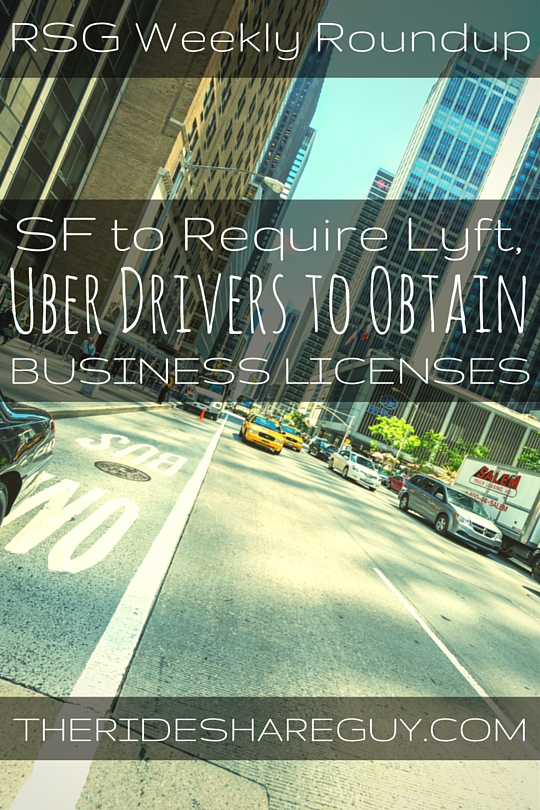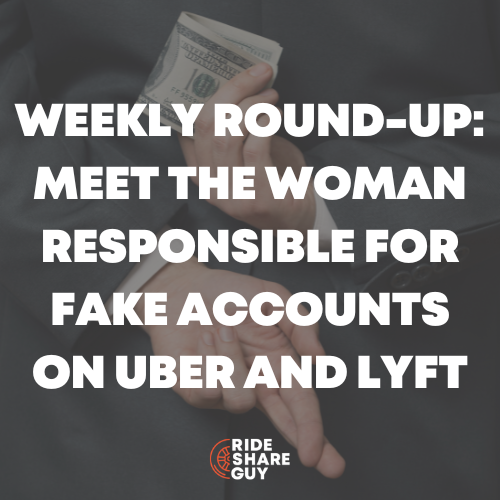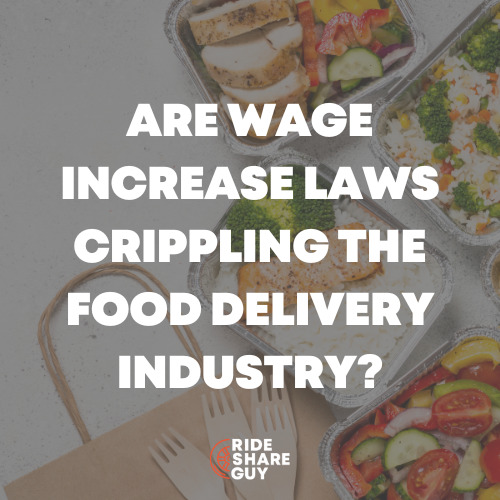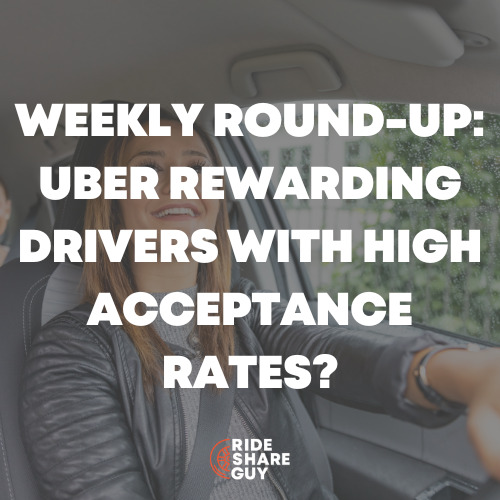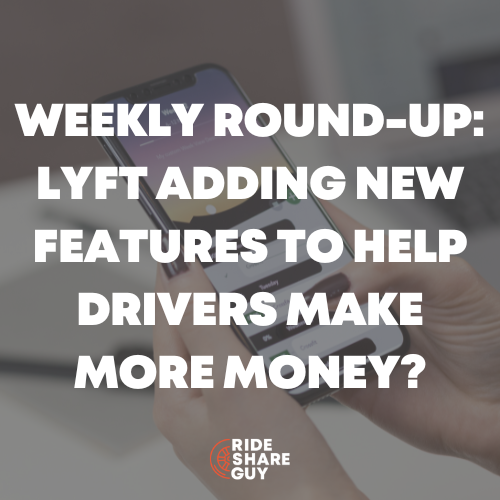Harry here. Yesterday, we broke news about the settlement of the Uber Employee Misclassification Lawsuit in California for $84 million and the reaction has been flowing in. If you’d like to join the discussion on that topic, please head to the comments section here.
Today, RSG contributor John Ince takes a hard look at a few other breaking news stories from the week. We’re still trying to figure out how the city of San Francisco got a hold of a list of Uber and Lyft drivers, but my money is on the tax records. $91 isn’t a lot of money but if it’s just another tax on people trying to earn a living, what’s the point?
SF to Require Lyft, Uber Drivers to Obtain Business Licenses
Sum and Substance: For the first time, San Francisco is going to require the 37,000 Lyft and Uber drivers who work in the city seven or more days a year to obtain a business license.
City Treasurer Jose Cisneros wouldn’t fully explain why he is now requiring the license, which will cost drivers $91 annually, when the companies started operations years ago. But one reason, he said, is that the city launched its online business registration system in March — before, registrants had to go to City Hall to apply in person.
This increases the political tension between the city and Uber and Lyft. When faced with class-action lawsuits from drivers seeking status as employees, the companies have vigorously maintained that the drivers are independent contractors. Cisneros is in essence turning that argument back on them and saying: if that’s the case, the drivers have to register as independent contractors for a business license.
Another reason the treasurer is taking action now may be that he finally has the names of the drivers. Uber and Lyft have long refused to provide drivers’ names and addresses to the city. Cisneros would not say how he obtained them.
The license will cost drivers $91 a year if they earn $100,000 or less in gross receipts. If they have been driving for multiple years, they will have to pay a registration fee for the years in which they didn’t register.
My Take: Message boards have been buzzing over this move by SF City Treasurer Cisneros. Drivers are wondering how this can be enforced. Will cops be looking in windows for business licences? I don’t think so. The big question seems to be “Why now?”
The article speculates that Cisneros wanted to do this all along, but didn’t have drivers addresses, and somehow he got his hands on a database – perhaps from a disgruntled ex-Uber employee. Uber, for its part, is taking a low profile on this one. Their text message to drivers was pretty tepid – essentially taking a wait and see attitude. Uber has a lot at stake in this one because it could add another barrier to entry for drivers and we know Uber has a problem with retention of drivers.
That’s Not Profit
Sum and Substance: According to a recent Bloomberg story, Uber earns an average of $0.19 per ride in North America when taking into account most costs associated with that revenue. However, in that average certain expenses are discounted, including “interest, taxes, [and] equity-based compensation for employees.”
It’s heartening to see Uber improve its unit economics in a key market. The progress points towards the company’s model having long-term legs; what it accomplishes here can likely be translated to less-mature markets where the company continues to spend heavily on growth and market share. But is Uber profitable in North America? No.
Let’s take a look. Normal accounting methods, often referred to as GAAP, or Generally Accepted Accounting Principles, don’t allow companies to exclude costs when calculating profit. Public companies must report their results using GAAP methods. Startups, however, often report their results on a cash-focused basis to their investors as it can be a more useful lens. Public companies may also present adjusted metrics in addition to their GAAP results.
My Take: The clock was ticking for Uber ever since they promised investors that they would start turning a profit by the second quarter of 2016. Well, Q2 2016 is here now and Uber came up with a “creative” way to make good on their promise – just don’t count the things that would force them to break their promise.
$1 billion of losses in China, nah, let’s not count that. Interest, taxes, [and] equity-based compensation for employees? Nah, let’s throw all those out for now. Presto, Uber is suddenly profitable … minus all the bad stuff. How long can Uber do this and still keep investors at bay? The answer is probably as long as Uber remains private. Until then, they only have to release information that they choose to release. But, if and when Uber goes public, then public scrutiny charges in.
Steve Wozniak Just Blasted Uber For Poor Treatment Of Workers
Sum and Substance: Apple co-founder Steve Wozniak just threw some shade at Uber.
On Monday, at the Future Transport Summit in Sydney, Australia, Wozniak denounced the ride-hailing company’s disputed labor practices and critiqued what he sees as its monopolistic ambitions, according to Mashable. “Like a lot of people, I have some distrust of Uber and how their drivers don’t really realize at first that they aren’t making much money, maybe losing money on the wear and tear of their cars,” Wozniak told reporters at the summit. “That’s how I think of Uber: Not very nice thoughts,” Wozniak added.
David Rohrsheim, general manager of Uber in Australia, responded to Wozniak’s remarks by noting that Uber drivers have a job with rare flexibility. “It has to be a good deal for partners or otherwise they won’t use the platform,” Rorhsheim told Mashable Australia.
Wozniak isn’t alone in criticizing the app. Class-action lawsuits filed by Uber drivers in California and Michigan argue that the company wrongly classifies its workers as independent contractors, allowing it to drive down their wages and withhold benefits. As contractors, drivers are exempt from minimum wage requirements and don’t receive certain state and federal benefits.
Both lawsuits contend that Uber drivers are, in fact, employees, a designation that comes with greater labor protections. Wozniak added that he’d prefer to use Lyft from now on. Lyft, which is Uber’s main competitor in the U.S., agreed in January to expand benefits for drivers. Lyft drivers can no longer be fired at will and have the right to settle termination and pay disputes through arbitration.
Despite those gains, Lyft drivers, like Uber drivers, are still considered independent contractors. Wozniak told reporters he’d also like to see more competition in the ride-sharing market. “I would rather there be a lot of competitive forces,” Wozniak said. “I’d like there to be four or five choice that are like Uber anywhere you go.”
My Take: Apple co-founder Steve Wozniak, a.k.a. Woz, isn’t saying a lot here that most of us don’t already know about Uber, but the fact that someone of his stature is saying it publicly is significant. I wonder how long Uber can continue in tone deaf mode to criticisms like this. At some point the drip, drip, drip of public sentiment against Uber starts to sink into the wider consciousness that affects the choices passengers make. Here Woz is saying that for him Lyft is a better alternative, because they treat drivers better. How many of you would agree with that assessment?
Sources: Shuddle’s collapse was the fault of Shuddle, not the investment climate
Sum and Substance: Last week, kids’ ridesharing company Shuddle abruptly shut down. The shutdown was widely covered, with most reporters agreeing on the same narrative: a difficult and more expensive to scale version of regular ridesharing just couldn’t get traction with new investors in this climate.
It’s a believable version of events, and one that Shuddle CEO Doug Aley was keen to push. As the Chronicle put it: the news underscores how tight venture capital has become, especially for younger startups that haven’t grown quickly enough. The on-demand sector, once a darling of investors, is particularly challenging for fundraising, Aley said. “My world has been colored by on-demand apocalypse headlines that littered the news over the past six to eight weeks when we were trying to raise rounds,” he said. Shuddle’s investors agreed.
In an email to Pando, Forerunner’s Kirsten Green wrote: “[There was a] perception it was a 1% problem. I think with scale prices could have come down. In the meantime, the choices are: you can give away the product for cheap as you strive toward scale if you had millions and millions to chase the opportunity or you can charge a fair price that enables drivers to be paid. Right now investor appetite for heavy investment early on is less than it was prior.” Even CB Insights “Mosaic algorithm” which purports to tell you how well companies are doing weighed in with similar analysis: “With Shuddle, an Uber for kids, shutting down, now all eyes should turn to competitor HopSkipDrive which raised money more recently but whose Mosaic score momentum doesn’t seem that impressive.”
Nothing to see here. Just a trapped company in a difficult sector in a rough fundraising market. HopSkipDrive could even be next. Or so Shuddle and its investors would like everyone to believe. But that’s not exactly the whole truth. I’ve spent several days speaking to people close to the situation and many of them are adamant that Shuddle’s problems had less to do with the funding climate and more to do with Shuddle itself. The company’s burn rate was far too high, and a change in CEO from founder Nick Allen to Aley was potentially too little, too late.
My Take: As usual Sarah Lacy of Pando Daily has dug beneath the surface to come up with more than the mainstream media reports. While other news outlets took Shuddle’s CEO Doug Aley’s line that they had to shutter Shuddle because of a shifting investment climate, Lacy, made a few calls and determined that Shuddle’s “burn rate” was unsustainably high. Of course these factors are integrally related. The faster your burn rate, the sooner you have to go back to the well and the less inclined previous investors are to throw good money after bad. What I wonder about here is whether anybody is taking a good hard look at Uber’s and Lyft’s burn rate. Uber is reportedly losing $1 billion a year in China. That’s a lot of money to be throwing at something that hasn’t even come close to showing a profit.
Fatal Lyft accident tests its insurance coverage
Sum and Substance: Eighteen months after an accident claimed the life of a 24-year-old Sacramento man taking a Lyft ride home on a rainy night, his mother and boyfriend are suing the San Francisco ride company. They claim that Lyft is dragging its heels on taking financial responsibility for a crash that the California Highway Patrol says was the Lyft driver’s fault.
“Losing my son is a black hole I live with all the time,” said Donna Dinapoli, 55, a Folsom resident. “And I’m angry because it was so senseless and didn’t have to happen if the driver had been more careful.” Lyft, despite its vaunted $1 million insurance liability policy, has not offered her compensation or even condolences, she said. “I think it’s a disgrace for a company as large as Lyft” to try to duck responsibility, Dinapoli said.
“Our hearts go out to the victims of this tragic accident,” Lyft wrote in a statement. “Lyft’s $1 million liability policy, which includes uninsured/underinsured liability coverage, is designed to provide coverage for Lyft drivers to protect passengers and third parties.” Sources familiar with the case said Lyft has not disclaimed responsibility for the accident, which was the young company’s first fatality. The delays stemmed from the investigation of the crash by Lyft’s insurance carrier — James River Insurance Co., which also insures Uber rides — a process that is still ongoing, they said. The legal case, which is still in the discovery process, also is likely to have a lengthy timeline. Dinapoli’s attorney said he hopes to go to trial by the end of the year.
My Take: In any new industry with new norms and practices, it takes awhile for the law to catch up with things. In this case it’s take a few years and that’s pretty frustrating for the parents of this young victim. Somehow that doesn’t seem right, but it’s the way things are. The insurance industry is notoriously slow in resolving claims. Any of you have experiences with insurance companies that seemed to take forever?
Readers, what do you think of this week’s round up?
